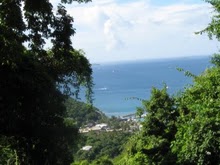 |
| Osprey in flight |
The brief glimpse I had of the Osprey, this time unfortunately did not afford me the opportunity to take pictures. Of course at the time my attention was focused on the salmon jumping in the water near the ship, who were sending great splashes of water into the air. They were huge. It made sense of course that I would see an Osprey just as the salmon were jumping, as the Osprey's diet consists of fish, and it is therefore often mistakenly called a Fish Eagle.
The second time I saw an Osprey
Ospreys are in a classification of raptor by themselves and have very specific physical adaptations designed for hunting fish. Their nostrils are capable of closing, for example to prevent water from entering when they stoop into the water after a fish. They also have backward facing scales on their talons to help them grip a fish they have captured more efficiently. To ensure that they are able to hang on to a fish that has been caught they have four toes, one of which is reversible.
Ospreys are easily recognizable in the sky by it's white under parts and narrow wings, tipped with four "fingers". Their wings are marked underneath by a large section of black and their back is dark while their head is white. They also have dark patches on their cheeks to distinguish them from other raptors.
 |
| Osprey wings spread |
These birds are global, meaning that they are seen world wide, not just in the western hemisphere of the planet. They are usually seen around bodies of water, be it rivers, lakes or sea shores. For a better view of this bird, or if you wish to learn more about it please follow these links:
http://en.wikipedia.org/wiki/Osprey
http://animals.nationalgeographic.com/animals/birds/osprey/
http://www.pandionhaliaetus.com/
Susan











No comments:
Post a Comment